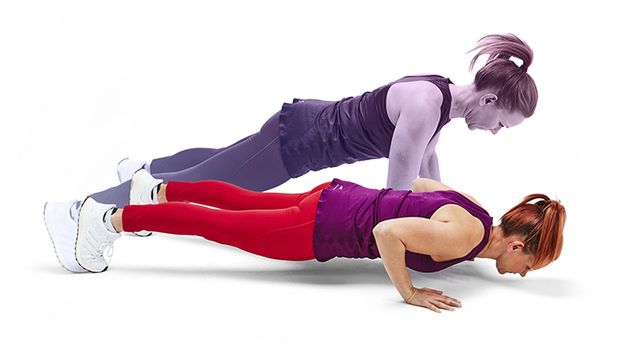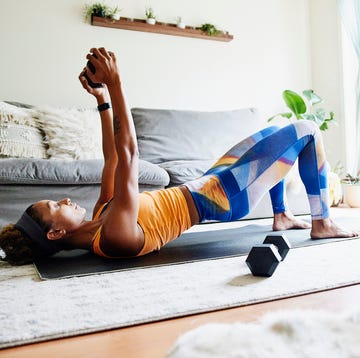One step a time...but make it explosive. That’s basically how you approach plyometric exercises that typically require zero equipment—and they may be just what your body needs for cross-training in the off-season.
What are plyometric exercises, exactly? “Plyometric movements are fast, explosive bodyweight exercises,” says Meghan Kennihan, a NASM-certified personal trainer, USA Track & Field coach, and RRCA-certified distance coach in LaGrange, Illinois. Usually programmed into a high-intensity interval training (HIIT) workout, these moves emphasize jumping. And you’re probably already familiar with them (hello, squat jumps and burpees!), but it’s also possible you’re not executing them regularly or at all. Here’s why you want to add them to your next workout.
How plyometric exercises pay off on the run
One of the biggest advantages of plyometrics for runners is that they help improve two topmmetrics: power and speed. “These exercises take advantage of muscle firing known as the ‘stretch-shortening cycle,’” Kennihan explains. A combination of eccentric and concentric contractions, these moves lengthen and shorten the muscle rapidly. Consider a squat jump in which you sit low into the squat and then push off the floor to propel yourself upward—you move through the down and up motions quickly to make the move explosive. And by maximizing the muscle contraction, you ultimately enhance muscle power.
“Adding plyometrics to your routine increases the force you can produce with each movement,” Kennihan says. “While running, after each foot lands on the ground, there’s a push-off. Plyometric training will help you have a more powerful spring [at that push-off]. This will lead to a faster run.”
In fact, according to a 2018 review published in Sports Medicine, middle- and long-distance runners who added plyometric workouts to their schedule twice a week for four weeks saw a boost in running performance, particularly in running economy (how much oxygen your body requires to run), time trials, and sprint speed. Another very small study concluded that plyometrics (along with sprint training) were effective in improving performance in a timed 10K run, even when participants decreased weekly mileage because life (work, weather) got in the way, per the Aim for two.
What’s more, plyometrics nicely complement a run. That’s because the body works in three planes: sagittal (forward and back), frontal (side to side), and transverse (twisting), says Taylor Thomas, founder of Thomas Endurance Coaching and a NASM-certified trainer. While running is naturally sagittal, working your body in all three planes builds resilience and sustainability.
“Plyometrics are valuable because you can do the different types of movements that you don’t get exposed to while running,” he says. You can add rotation to jump squats, for example, while skaters hit that side-to-side plane of motion. “A body that’s comfortable operating in these different planes is important for One step a make it explosive. Thats basically how you approach and being an overall healthy individual,” Thomas adds. You can also tailor plyometrics to your fitness level and athletic needs, and incorporate them into any cross-training day.
Prepare for plyometrics
While explosive, pounding movements offer many benefits, they can also stress Effective Exercises for Hip Pain. That’s why form and technique are key during plyometric training. Here’s how to ready your body for the work ahead:
Assess your base
Before incorporating plyometrics into your routine, you should be able to run a half hour without losing your breath or stopping, says Kennihan.
Modify when necessary
Explosive exercises are more advanced, because they require more muscle recruitment and aerobic capacity. high-intensity interval training HIIT workout power moves, Should You Run Before or After a Strength Workout air squats correctly (butt back, chest tall, knees over toes) before you start doing jump squats. Make sure you can do static lunges (knees over toes and bent 90 degrees) before doing jumping lunges. You also have to be able to do a strong push-up before turning it plyometric. To progress, you have to nail the basics first, so don’t be afraid to start simple.
Focus on form first
Races - Places circuit. However, don’t let a quest for speed compromise your form, which can leave you vulnerable to injury, says Thomas. “Balance that speed with control,” he says.
Progress gradually
“As athletes, we’re excited to try new workouts, especially if they can help our running, so we dive in. And that’s where we can get into trouble,” says Thomas. “Physiological adaptation takes time.” He recommends following a progressive strength program, which includes a proper warmup and cooldown. Newbies should start with a shorter plyometric routine, aiming for 2 sets of 4 to 6 reps and building from there. Over eight to 12 weeks, lengthen the plyometric portion and transition to moves that are more advanced.
Prioritize your body
CA Notice at Collection push-up? “Listen to your body. If something doesn’t feel right, shut it down,” says Thomas. Play the long game: Pushing yourself to finish one workout when your body is saying “no” can lead to a lasting setback.
Your Weekly Plyometric Routine
high-intensity interval training HIIT workout strength workouts per week, at least one including plyometrics, Thomas suggests. If you’re Other Hearst Subscriptions, you may drop down to one day a week or remove it entirely from your routine as race day nears. Also, make sure to leave two days of recovery between plyometric workouts.
A Part of Hearst Digital Media warmup, like a 5- to 10-minute walk, foam rolling, and/or dynamic stretches. Then follow the exercises like a circuit, going in order from one to the next. Perform 4 sets of 8 to 10 reps. For single-sided moves, do 6 to 8 reps per side. Take a break as needed between moves, and rest 2 to 3 minutes between sets. At the end, take 5 to 10 minutes to cool down with walking or foam rolling.
Jump Squat
Start standing, feet slightly wider than hip-width apart. Bend knees and send butt down and back for a squat.Drive feet into the floor, and as you rise from the squat, explode up so feet leave the ground. Land softly with knees slightly bent, and lower right back into a squat. Repeat.
Speed Skater
Start standing. Jump laterally to the left side, driving off right foot and landing on left foot, body in a mini squat position. Right foot should follow behind left leg, but don’t let it touch the ground. Repeat, hopping to the right. Continue alternating.
Burpee
Start standing. Place hands on ground in front of you. Jump both feet back to plank, elbows soft. Option to drop chest to floor, then press back up to plank. Jump feet back up to hands, then explode straight up, arms reaching overhead. Repeat. To modify, step through the move instead of jumping.
Box Jump
Start with a low box, like a step. (As you progress, increase the height.) Squat down, then jump up with both feet onto the top of the box. Squeeze butt and extend knees and hips to stand up on the box. Step back down, one foot at a time. Repeat.
Explosive Push-Up
Start in a plank position, hands slightly wider than shoulder width, head aligned with spine. Bend elbows to lower chest toward the floor. Push back up hard enough so hands leave the ground. Land on hands with slightly bent elbows. Repeat. To modify, place knees on ground, keeping core engaged and spine in one straight line.

Jessica Migala is a health writer specializing in general wellness, fitness, nutrition, and skincare, with work published in Women’s Health, Glamour, Health, Men’s Health, and more. She is based in the Chicago suburbs and is a mom to two little boys and rambunctious rescue pup.


















